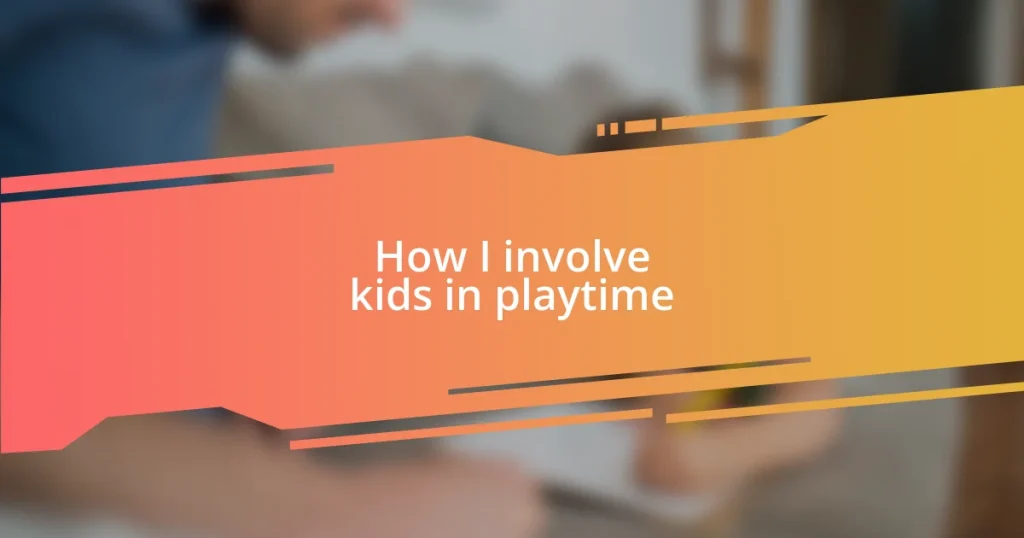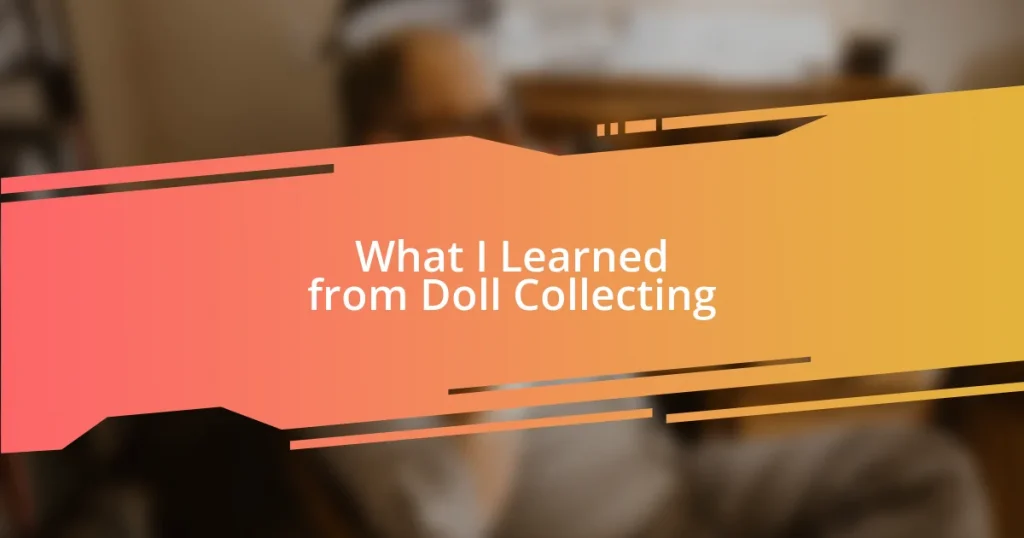Key takeaways:
- Playtime is essential for childhood development, enhancing cognitive abilities, social skills, and emotional well-being through imaginative and interactive experiences.
- Choosing play activities based on children’s interests fosters engagement, creativity, and deeper connections, enabling them to express themselves and develop critical life skills.
- Evaluating playtime experiences and incorporating feedback helps refine activities, ensures inclusivity, and highlights the learning outcomes of playful interactions.
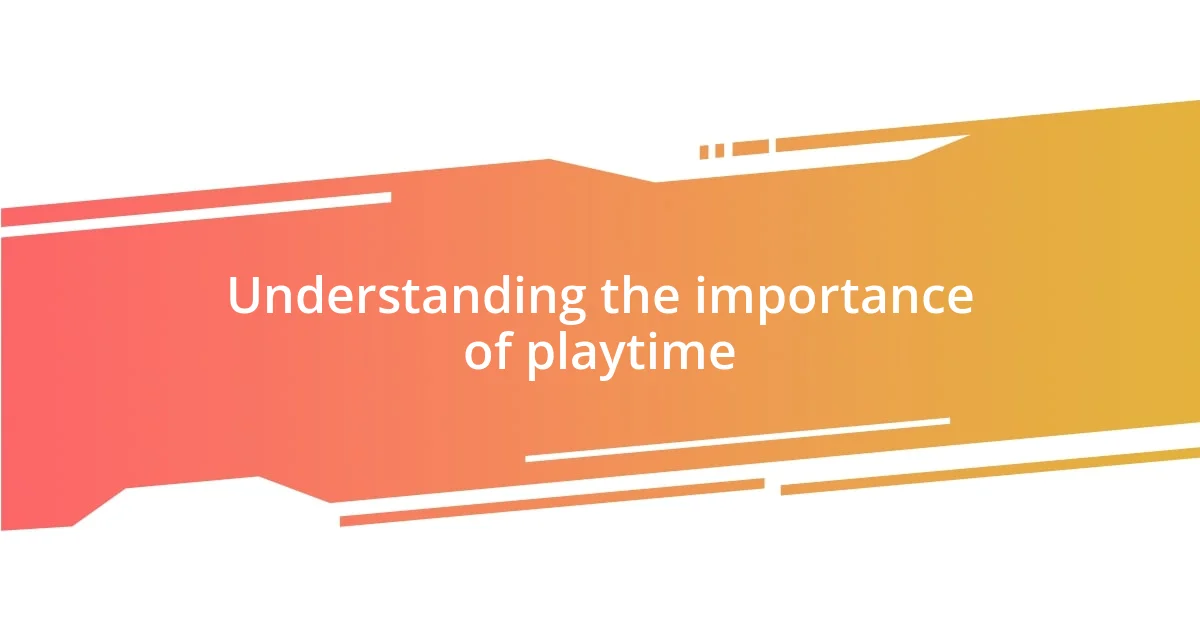
Understanding the importance of playtime
Playtime is not just a pastime; it’s a vital part of childhood development. I remember watching my daughter at the park, completely immersed in her imaginative play with other kids. It struck me how that carefree laughter and creativity were building not only her social skills but also her emotional resilience. How often do we think about the profound effects of those simple moments?
Research shows that playtime enhances cognitive abilities and helps children learn how to navigate conflicts. I can’t help but reflect on a time when my son had a disagreement over sharing toys during play. Observing him work through that situation taught him empathy and negotiation—a crucial life skill. Isn’t it fascinating how such small interactions can lead to significant growth?
It’s also essential to recognize that play nourishes the emotional well-being of children. The joy they find in play often serves as a safe space for them to express feelings or unwind from stress. When my kids build a fort out of couch cushions, I see their worries fade away, replaced by pure excitement and laughter. What better way is there to foster their mental health than through the simplicity of play?
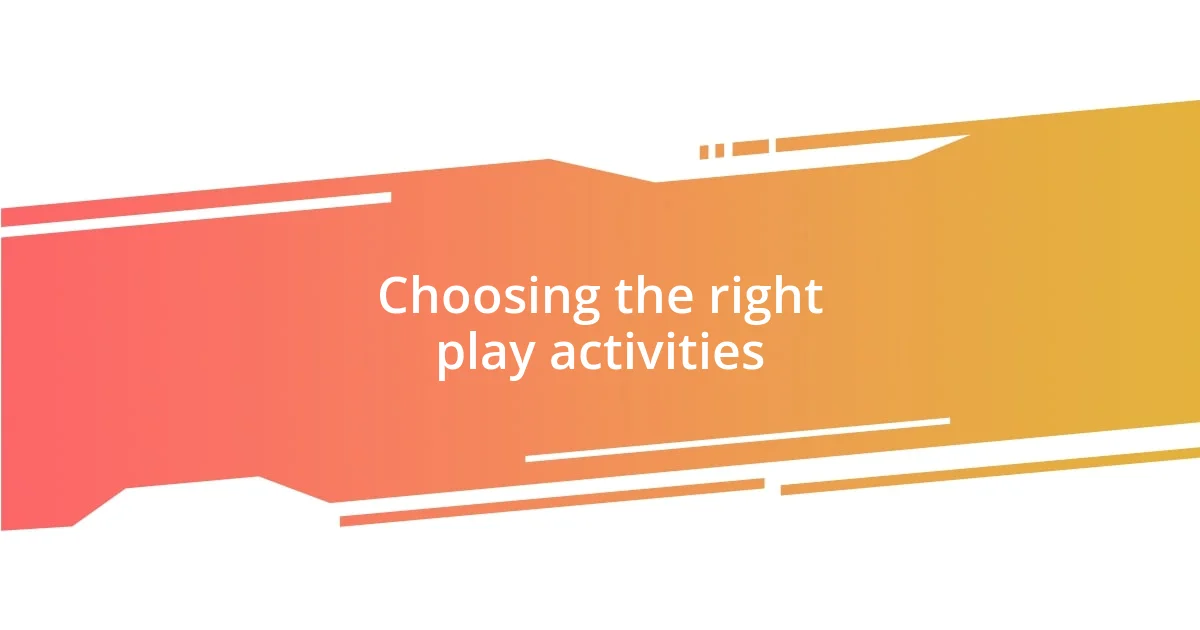
Choosing the right play activities
Choosing the right play activities is all about tuning into your child’s interests and developmental needs. I’ve found that when I let my kids take the lead in selecting activities, their engagement skyrockets. For instance, one day, my daughter insisted on a scavenger hunt around the house. What started as a simple search for hidden toys turned into a cherished memory, filled with giggles and teamwork.
When selecting play activities, consider options that foster creativity, physical movement, and social interactions. Here’s a quick list of ideas that I’ve found work wonders:
- Arts and Crafts: Setting up a painting station that allows for expression and creativity.
- Outdoor Games: Organizing tag or relay races to get those bodies moving and hearts racing.
- Role Play: Encouraging dress-up play that lets kids explore different characters and scenarios.
- Building Projects: Providing blocks or construction sets to inspire imagination and problem-solving.
- Nature Exploration: Taking a walk in the park to collect leaves or rocks, turning it into a learning opportunity.
By blending these activities into playtime, I’ve noticed not only increased happiness but also deeper connections with my children, fostering a sense of joy and nurturance in our time together.
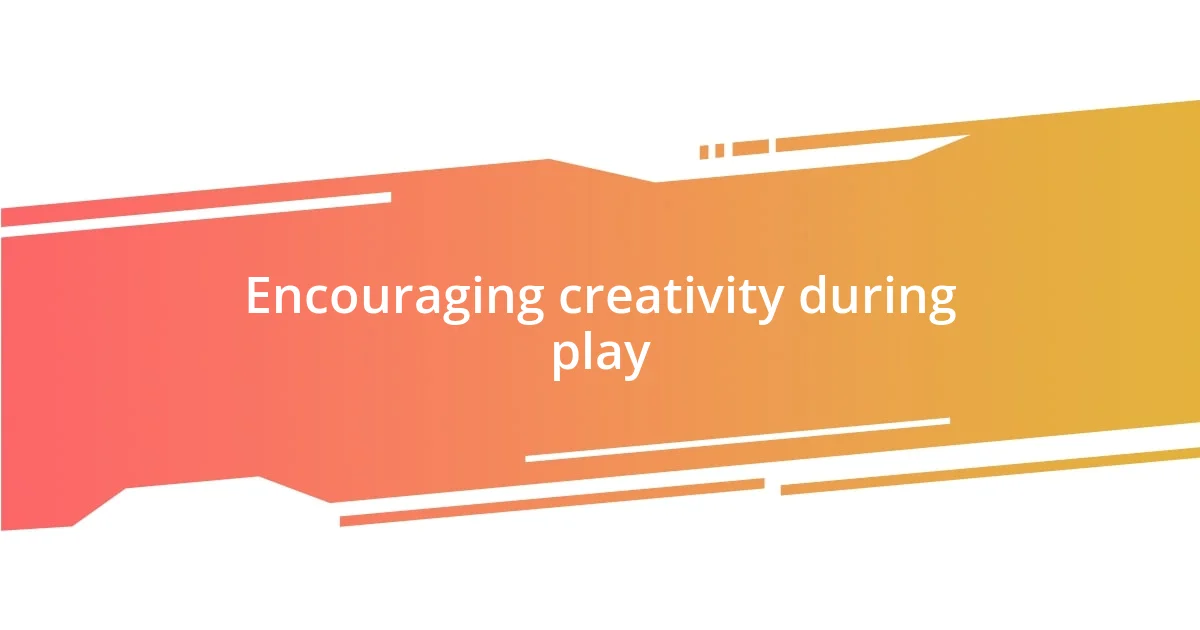
Encouraging creativity during play
Encouraging creativity in play can be a magical experience. I recall a rainy afternoon when my kids and I decided to build a spaceship out of cardboard boxes. We transformed mundane materials into a vibrant flying machine, complete with imaginary controls and sound effects. Watching their faces light up as they engaged in this spontaneous adventure reminded me how even the simplest props can ignite boundless imagination.
In my experience, providing open-ended play experiences really encourages creativity. For instance, when I set out art supplies without any strict instructions, my children dive into their own creations without fear of making mistakes. One day, my son used a mix of paints, crayons, and even some old magazines to create a collage that told a story. I loved seeing his thought process come alive—his creativity knew no bounds, and it was a reminder of how play can be a true expression of self.
Another approach I’ve found effective is incorporating elements of storytelling into our playtime. Last week, I introduced a puppet show, where each child created their own puppet and character. They took turns weaving together their stories, showcasing their unique perspectives. The excitement and laughter that ensued showed me how vital it is to foster a space where their ideas can flourish freely. How often do we, as adults, overlook the importance of storytelling in nurturing creativity?
| Activity | How It Encourages Creativity |
|---|---|
| Building Projects | Inspires problem-solving and imaginative structures. |
| Art Stations | Allows free expression without limitations. |
| Puppet Shows | Encourages storytelling and character development. |
| Scavenger Hunts | Promotes critical thinking in a playful context. |
| Role Play | Fosters empathy and exploration of different scenarios. |
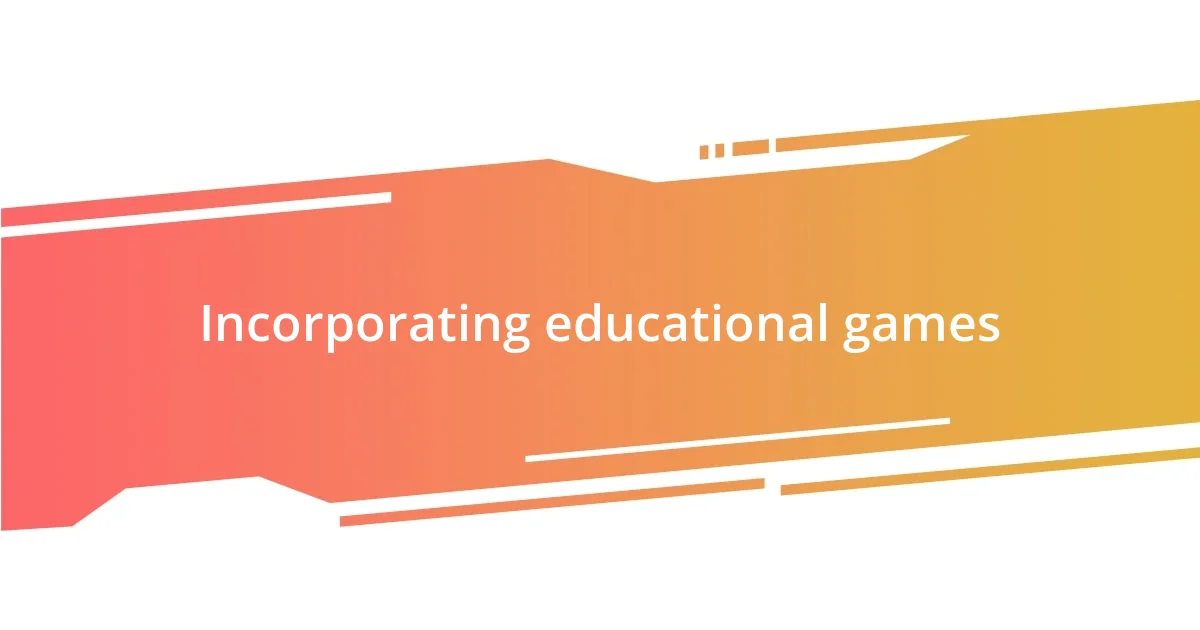
Incorporating educational games
Incorporating educational games into playtime is a fantastic way to blend fun with learning. I remember a time when I introduced math-based board games during family game night. Watching my kids navigate through questions while racing to the finish line was thrilling, and it struck me how effortlessly they absorbed math concepts while having a blast. It made me realize that learning doesn’t always have to feel like teaching; sometimes, it can be both playful and educational.
From my perspective, language-based games can spark curiosity too. I once had my children create a silly word game where they combined their favorite animals with crazy adjectives, resulting in creatures like the “Fluffy Blue Elephant.” The joy in their laughter, combined with their eagerness to come up with new words, revealed the incredible potential these games have to develop vocabulary. How many times do we overlook the richness of language in play?
I find that science experiments disguised as games hold a unique charm as well. One day, we turned our kitchen into a laboratory to test various liquids on plant growth, crafting hypotheses and observing results. The excitement on my kids’ faces as they saw their little plants sprout brought a depth of understanding that a textbook never could. This hands-on experience taught me that educational games can unlock real-world connections, turning playtime into valuable exploration moments. Wouldn’t it be wonderful if every playtime could ignite that sense of discovery?
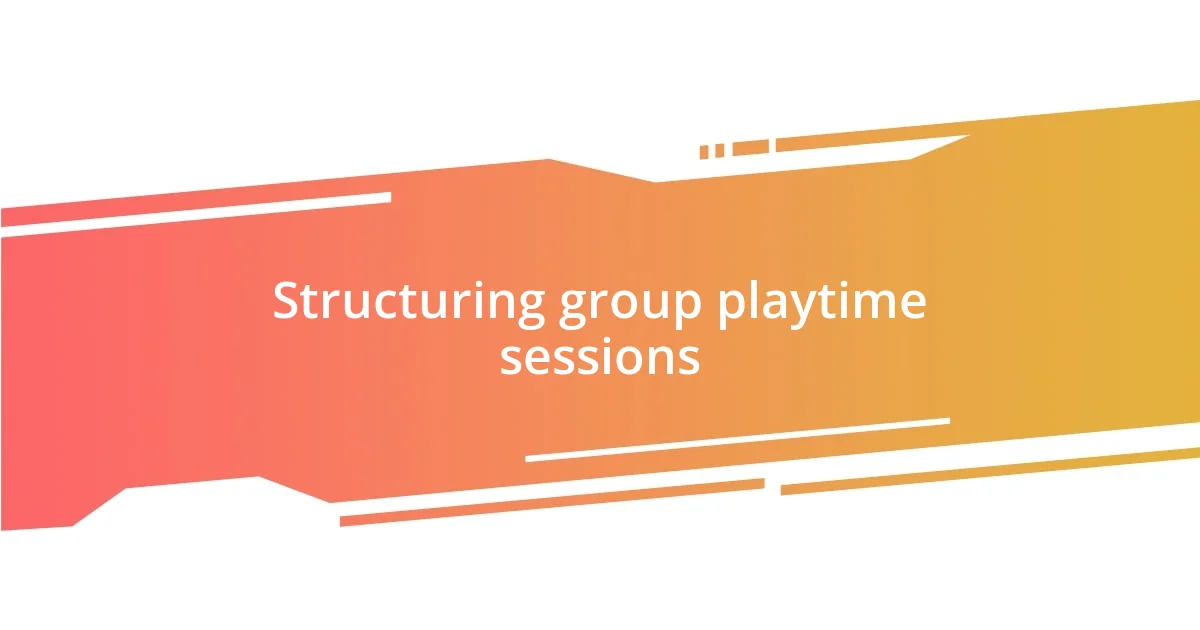
Structuring group playtime sessions
When structuring group playtime sessions, I’ve discovered that setting clear objectives can guide the experience. For example, I once organized a collaborative building activity where we worked together to create a massive cardboard city. By assigning different roles—architect, construction supervisor, and decorator—each child felt a sense of purpose and ownership. It was fascinating to see how they took pride in their contributions, knowing they were part of something bigger.
I also believe that balancing structure with flexibility is key. One afternoon, I planned a nature scavenger hunt with specific items to find. However, when the kids became captivated by a particularly interesting rock or feather, I encouraged them to explore beyond the list. This spontaneous deviation added an element of discovery that exceeded my expectations. How often do we allow ourselves to be guided by curiosity rather than rigid plans?
In my experience, rotating leadership roles among the children can enhance engagement. During group circle time, I had each child take turns leading a game, which encouraged them to express their ideas confidently. Watching the quieter ones step into leadership roles was incredibly rewarding. I realized that fostering this kind of empowerment encourages kids not just to play but to grow! Isn’t it amazing how structured play can cultivate essential life skills like teamwork and leadership?
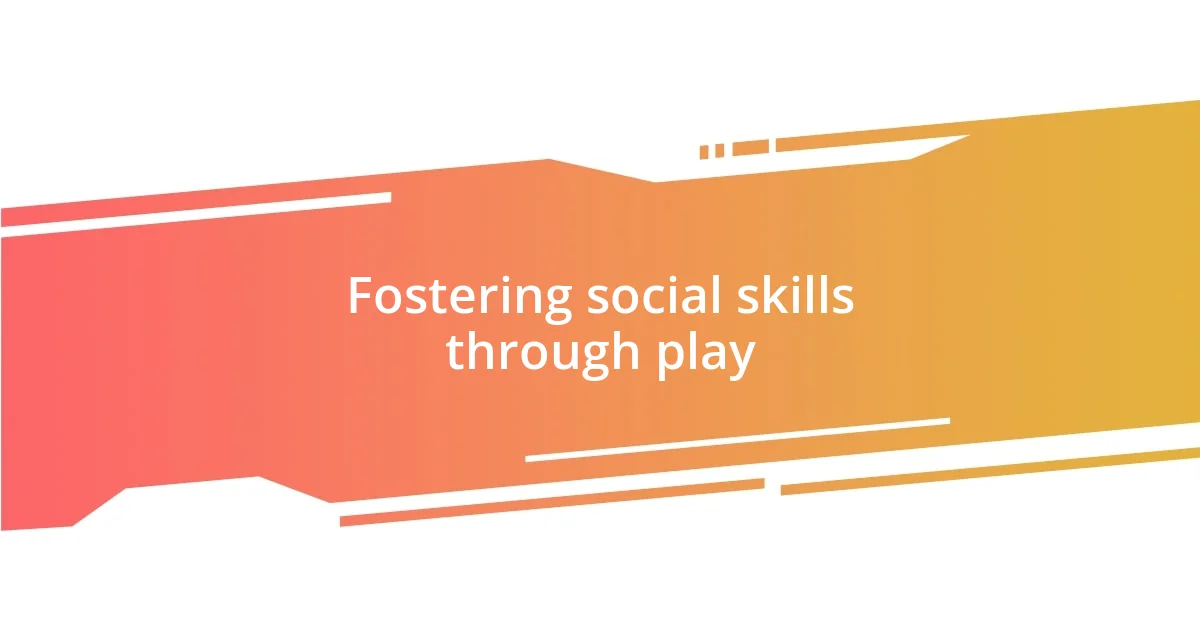
Fostering social skills through play
Fostering social skills through play is one of the most rewarding aspects I’ve experienced as a parent. The other day, my kids hosted an impromptu “puppet show” where they not only created the puppets but also devised a storyline together. Watching them negotiate roles and bounce ideas off each other was fascinating. It struck me how they learned to listen, compromise, and express their thoughts all while immersed in creativity. Isn’t it incredible how play can become a natural training ground for communication?
During another play session, we decided to play “Simon Says,” which turned out to be a brilliant way to teach not just following directions, but also the importance of being attentive to others. As my children took turns leading, I noticed some children shining with confidence while others hesitantly found their voice. The moment I saw the quieter kids beam with pride when they successfully led the game, I felt a wave of joy. This experience reinforced my belief that through playful interactions, kids not only develop social skills but also nurture their self-esteem.
Reflecting on my own childhood, I remember playing cooperative games where winning wasn’t the focus but rather teamwork was. Recently, I introduced a similar concept to my children by setting up a group obstacle course that required collaboration to succeed. It was heartwarming to see them cheer each other on and celebrate small victories together. I believe that such moments foster empathy and a sense of belonging. How many of us, as adults, would benefit from revisiting the joy of working together with a shared goal?
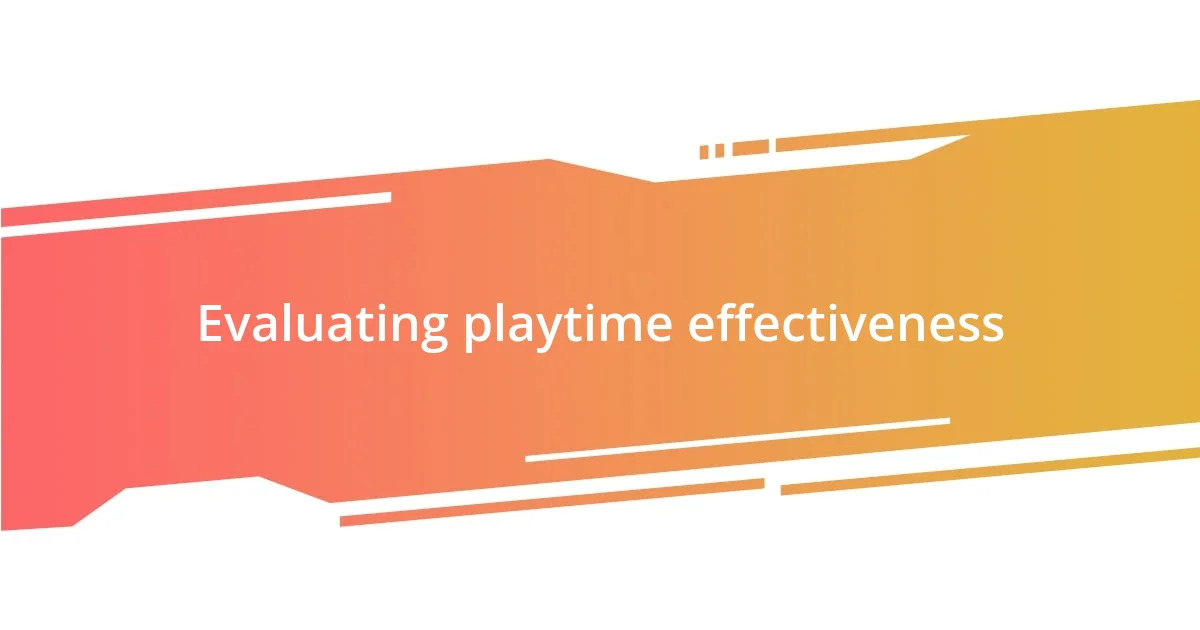
Evaluating playtime effectiveness
Evaluating playtime effectiveness can be quite enlightening. I remember a day when we turned a simple game of tag into a mini competition with different scoring systems. Afterward, we gathered in a circle to discuss how everyone felt about the activity. The kids shared their thoughts on teamwork and frustration, which gave me insight into their emotional experiences during play. Reflecting on this, I realized how vital it is to ask for feedback; it can highlight areas of improvement.
Beyond just enjoyment, I like to focus on the skills children develop during playtime. One afternoon, we played a game that involved passing a ball while sharing stories. I was amazed at how this not only enhanced their listening skills but also encouraged them to think creatively. When the session was over, we discussed what they learned about collaboration and communication. It struck me how play can serve as an informal assessment for deeper learning—have you noticed how children often absorb lessons without even realizing it?
Regularly measuring the impact of playtime helps me fine-tune each session. I’ve started using a simple chart where kids can rate their experience after each activity. One day, the feedback was overwhelmingly positive for a pretend market they created, but some felt left out. This insight was invaluable. It reminded me that every child’s experience matters, and as a facilitator, I need to adapt to ensure everyone is included. How often do we pause to really listen to what our children are telling us about their play?










